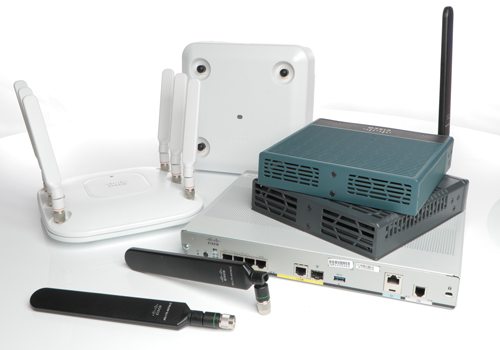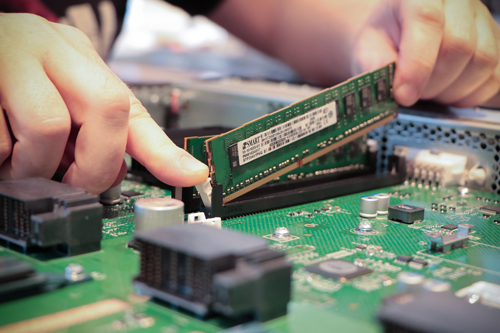‘Digital CO2 footprint’ - what is that?
Just as one's own carbon footprint refers to the greenhouse gases caused personally, the digital carbon footprint is defined by the environmental impact of digital technologies and activities. This includes emissions and energy consumption during the production, use and disposal of devices, networks and online services in order to reduce this digital carbon footprint, companies now look for solutions to reduce their electricity and water consumption, minimise their electronic waste and improve their impact on the environment as part of the Green IT drive. While these sustainability strategies require some initial investment, they already offer huge economic and environmental benefits for the organisation and our shared world in the medium term. The possible sustainability strategies can be categorised into two different concepts:
Greening by IT: IT is used to improve sustainability within the company.
Greening of IT: The sustainability of IT itself is to be improved through lower resource consumption and increased energy efficiency.

More sustainability in IT - 10 concrete measures
IT companies are no longer turning a blind eye when it comes to their CO2 emissions, but are beginning to recognise their responsibility. After all, those who make their contribution to climate and environmental protection are investing in their company's image, increasing their operational efficiency and the future of us all. This is why more and more intelligent and innovative solutions are being developed to reduce the digital footprint with IT and in IT and to improve the carbon footprint of companies worldwide. The following measures can be taken to make the IT industry more sustainable:
Energy-efficient hardware: using energy-saving devices and extending their useful life reduces energy consumption and cuts CO2 emissions during operation and production.
Cloud solutions: Cloud architectures optimise the use of resources through shared data centres and reduce the energy requirements of individual end devices, particularly through the use of energy-efficient infrastructure.
Sustainable energy sources: Operating data centres and IT infrastructure with solar, wind or hydroelectric power helps to reduce fossil fuel dependency and therefore CO2 emissions.
Efficient data management: techniques such as data compression, deduplication and automated storage management reduce storage requirements and lower the energy consumption of data centres.
Resource-saving software: optimised software architectures, resource-efficient programming languages and minimal computing effort save energy and improve the sustainability of digital applications.
Recycling/refurbishment: The reuse of hardware and responsible disposal of electronic waste prevent environmental damage caused by toxic materials and promote a circular economy.
Remote working: working from home and digital collaboration reduces commuting and business trips, which lowers the energy consumption of offices and means of transport.
Employee sensitisation: training and campaigns create awareness of sustainable IT practices and motivate employees to actively contribute to reducing the digital carbon footprint.
Green computing initiatives: programmes to promote energy-efficient IT technologies, environmentally friendly procurement guidelines and recycling processes support companies in establishing more sustainable processes.
Energy management: monitoring systems record the energy consumption of IT systems and identify optimisation potential in order to reduce CO2 emissions in a targeted manner.


Corporate social responsibility and digital decarbonisation
To counteract accelerated climate change, everyone must take action and reduce their carbon footprint - both individuals and companies. As part of corporate social responsibility, companies around the world are therefore committing to conducting their digital activities in an ethical, responsible and sustainable manner. In doing so, they not only comply with legal regulations, but also embed green IT in their corporate goals and endeavour to take proactive digital measures for greater cyber security, sustainability and climate neutrality. A core aspect of this is digital decarbonisation, which involves reducing CO2 emissions in IT - from the production and use of digital devices to their disposal. But some companies are even going one step further: the Carbon Net Zero concept (also known as net zero emissions or CO2 neutrality) aims to achieve a balance between generated and offset emissions. Through clean energy sources, a reduction in energy consumption and sustainable IT, the aim is to completely negate the digital footprint.
Conclusion: Digital progress only in harmony with nature
The IT industry plays a central role in the fight against CO2 emissions and climate catastrophes. Firstly, because it can find new solutions to environmental problems through technological progress - from precise climate monitoring and intelligent waste management to sustainable energy distribution and secondly, because it can reduce global CO2 emissions significantly through resource-conserving, climate-neutral and fair energy management. Greening by IT and Greening of IT are therefore the guiding principles of a future in which people, the environment and IT complement each other. Sustainable IT for a future worth living.
We have established ourselves as experts in IT remarketing in the context of sustainable IT hardware. That's why you'll find refurbished hardware in our shop in the form of refurbished servers, switches, routers and much more. Do you need support in reducing your CO2 emissions? We will be happy to advise you on how you can reduce your IT operating costs and your digital footprint at the same time by using refurbished devices.
